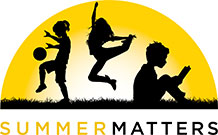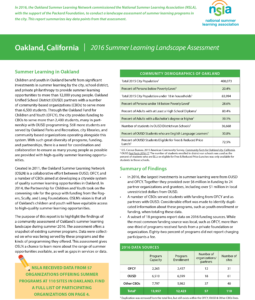OSLN 2016 Summer Learning Landscape Assessment
Summer Learning in Oakland
Children and youth in Oakland benefit from significant investments in summer learning by the city, school district, and private philanthropy to provide summer learning opportunities to more than 12,000 young people. Oakland Unified School District (OUSD) partners with a number of community-based organizations (CBOs) to serve more than 6,500 students. Through the Oakland Fund for Children and Youth (OFCY), the city provides funding to CBOs to serve more than 2,400 students, many in partnership with OUSD programming. Still more students are served by Oakland Parks and Recreation, city libraries, and community based organizations operating alongside this system. With such great diversity of programs, funding, and partnerships, there is a need for coordination and collaboration to ensure as many young people as possible are provided with high-quality summer learning opportunities.
Created in 2011, the Oakland Summer Learning Network (OSLN) is a collaborative effort between OUSD, OFCY, and a number of CBOs aimed at developing a citywide system of quality summer learning opportunities in Oakland. In 2014, the Partnership for Children and Youth took on the convening role for the group with funding from the Rogers, Scully, and Long Foundations. OSLN’s vision is that all of Oakland’s children and youth will have equitable access to high-quality summer learning opportunities.
The purpose of this report is to highlight the findings of a community assessment of Oakland’s summer learning landscape during summer 2016. The assessment offers a snapshot of existing summer programs. Data were collected on who was being served by these programs and the kinds of programming they offered. This assessment gives OSLN a chance to learn more about the range of summer opportunities available, as well as gaps in services or data.
Summary of Findings
- In 2016, the largest investments in summer learning were from OUSD and OFCY. Together they provided over $6 million in funding to 24 partner organizations and grantees, including over $1 million in local unrestricted dollars from OUSD.
- A number of CBOs served students with funding from OFCY and as partners with OUSD. Considerable effort was made to identify duplicated information about these programs, such as youth enrollment or funding, when totaling these data.
- A subset of 18 programs report data on 2016 funding sources. While the most common funding source was local, such as OFCY, more than one-third of programs received funds from a private foundation or organization. Eighty-two percent of programs did not report charging participants a fee.




